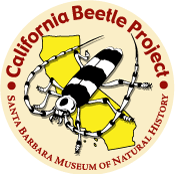|
|
|
|
| Collections and Research Online Databases - California Beetle Project |
|
NOTE: As of 2014, the California Beetle Project page is no longer updated. The original database and list of California beetles in the menu on the left will remain for the time being, but the information contained within is not necessarily current. SBMNH Entomology Curator Matthew L. Gimmel has divided up the function of the original database into two conceptual halves:
|
 • Home/Overview • Checklists • Database • Fieldwork • Phylogeography • Photo Gallery • Species pages • Endangered beetles • Personnel • Informatics • Collaborators • Collection • Bibliography • Support the project • Beetle links
|
California Beetle Project > Database introduction
The California beetle database Simple Search Advanced Search Taxonomy Browser Welcome to the online California beetle database. This database contains near 150,000 records of beetle species in California, including collection and literature records. Nearly three-fourths of these records are georeferenced and mappable. The database contains over 100,000 records of specimens in the SBMNH collections, in addition to tens of thousands of historical records transcribed from the literature. The simple search should serve most users' needs. It produces species lists for a specified family, genus, county or managed area, and provides links to species pages, specimen data and maps. The advanced search permits more detailed queries for specialist users. The Taxonomy Browser is the place to start if you want to drill down through a list of all families, then genera and species in the database.
For details on how the database works see the CBP informatics page. Any comments or questions on the database may be sent to the project's former coordinator, Dr. Matthew L. Gimmel. 
|